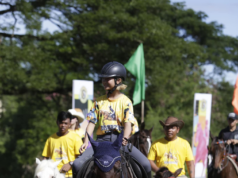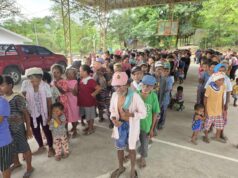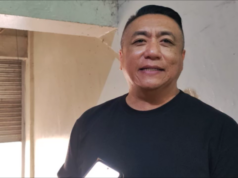File photo shows hill scraped of vegetation at Donggwang project site.
CLARK FREEPORT – Officials of the Clark Development Corp. (CDC) have belied reports that some 40,000 trees were cut to give way to the $153-million, 304-hectare project of the Korean firm Donggwang Clark Corp. (Donggwang) here.
Briefing members of Kapampangans in Media, Inc., CDC environment manager Red Fuentes said an inventory of the area in 2011 indicated that the site, which covers a bulldozed hill, only had 840 full grown trees and 25 clusters of smaller trees, as certified by the Department of Environment and Natural Resources (DENR).
“Donggwang cut only 130 trees which it initially wanted to just transfer to other areas. The trees were cut upon the advise of the DENR because the trees were known to be of the invasive varieties, such as the Japanese acacia and the African tulip,” Fuentes said.
Both CDC, the state-owned firm that manages this freeport, and Donggwang came under fire from local environmental groups which claimed that as many as 40,000 trees were cut for the project.
The groups also blamed the project for the drying up of an aquifer that provides potable water to folk in nearby Sapang Bato in Angeles City, as well as for silt that flows into nearby communities during heavy rains.
The CDC leased the project area to Donggwang in 2010 for the development of the Sunvalley Leisure Community Project. The site was initially leased to Tru North for a golf course but was never realized.
Frank Madlangbayan, CDC vice president for operations, said the Donggwang project covers the construction of a 36-hole golf course, a golf academy and driving range, Brent International School, a 300-room hotel, 500 units of “garden” villas and apartments, a commercial and shopping arcade, and an eco-tourism and water park.
Fuentes also debunked allegations that Sapang Bato’s aquifer was drained by the on-going project of Donggwang, saying that the project does not have a water pump as it would rely on water impounding structures filled up by rainfall.
He also dismissed claims that the project, which also involved bulldozing the top layer of a hill, has been causing earthen silt to flow to nearby areas. He said Donggwang had constructed a series of sediment traps and silt dams against such occurrence.
Fuentes quoted Lormelyn Claudio, regional director of the Environmental Management Bureau (EMB) as saying that the Donggwang project was “environmentally compliant.”




